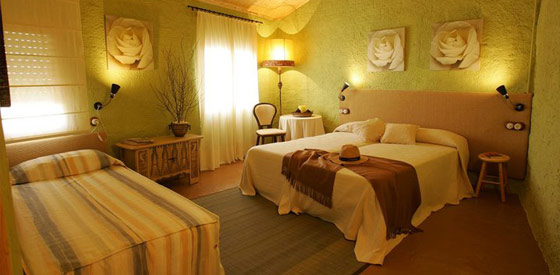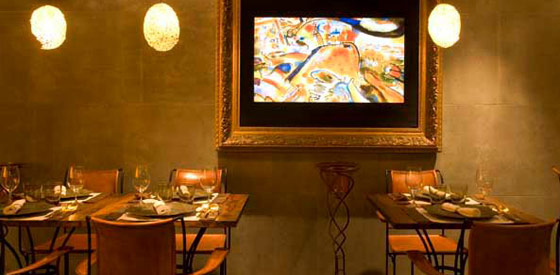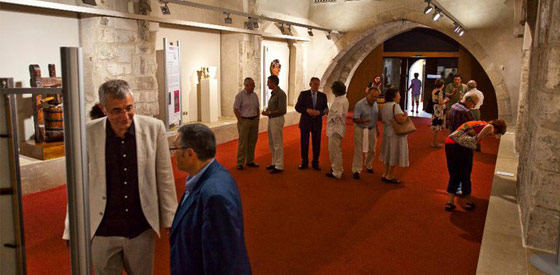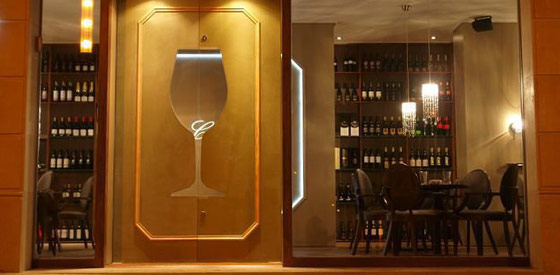1. Where to Stay

Bring back a couple of bottles from your vineyard crawls and throw a DIY wine tasting in the dining room of Ca la Laia (from $80/room, or $990/week for the house), a farmhouse built in 1879 in the small, stone village of Torrelles de Foix. Expect the hallmarks of country living: beamed ceilings, floral bedspreads, a wine barrel as a table, and a wood-burning fireplace.
Survey the medieval center of Vilafranca del Penedès from your tiny but beautifully restored wrought-iron balcony at the boutique hotel Casa Torner I Güell (from $175), housed in a graceful building constructed in 1884. The stylish interior features artful nods to the wine region, with glass walls made from recycled bottles of cava and original stone foundations glowing under recessed lights.
Sleep like a monk at the honey-hued Hospedería del Monasterio de Poblet (977-870-089; from $120), which opened in summer 2010 on the grounds of the eleventh-century Poblet monastery in the neighboring region of Tarragona, a 45-minute drive west of Penedès. Though it was designed by the renowned Spanish architect Mariano Bayón as a blend of modern and ancient, the emphasis is on simple living here, with no TVs in the basic rooms, and nightly Gregorian chanting in the chapel.
2. Where to Eat

Feast like a medieval Catalan at the warmly lit Ú Restaurant, which features a menu rooted in the middle ages. Owner Raimon Olivella follows two of Catalonia’s most famous medieval cookbooks—the Libre de Sent Soví (1324) and the Libre del Coch (1520)—to create a tasting menu ($40) with dishes like roasted eggplant stuffed with egg, and foie gras with a gelatin of Xarel•lo, the region’s best-known white grape, used to make cava.
Follow local winemakers to their lively hangout, Cal Xim in Sant Pau d’Ordal, which excels at grilled meats paired with local produce. Try the blood sausage with white Catalan heirloom beans ($14) or duck with candied pears ($22). The owner maintains a superb cava list that spotlights small regional wineries; order a bottle of hard-to-find Aguilera ($20).
Try Spanish locavore cuisine—rabbit cannelloni draped in truffle béchamel ($17) or squid stuffed with Tou dels Tillers, a lightly salted, local, creamy cow’s cheese ($19)—at El Racó de la Calma in Vilafranca del Penedès. If your schedule allows, stop in for the three-course prix-fixe lunch ($19) on weekdays.
3. What to Do

Skip the familiar cava-producing giants—Codorníu and Freixenet, both headquartered in Sant Sadurní d’Anoia—and instead head to MasCandi (guided visits, $12), an ecofriendly winery run by four young oenophiles 6 km north of Vilafranca del Penedès. In 2010, they began planting historic Catalan grape varieties that hadn’t been harvested since the 1800s. Top off the tour on the sunny terrace, sipping a bright, tart glass of Brut Nature cava ($9 per bottle).
Drink organic cava while standing in the vineyard of origin at the family-owned Parés Baltà (guided visits, $16), about 5 km northwest of Vilafranca del Penedès. Bump along on a four-wheel-drive guided tour across the winery’s five estates and see their organic methods firsthand, like flocks of grazing sheep that help fertilize the land. Pick up a bottle (or five) of Parés Baltà Ros de Pacs ($11), voted best Spanish rosé by the New York Times last summer, or splurge on the organic cava Rosa Cusine 2007 ($40), which debuted in October and received a limited production of 500 bottles.
Be the first to explore the new Vinseum ($7; call ahead to confirm open hours), the first museum dedicated to the wines of Spain, which is going through the finishing touches of a five-year makeover in a thirteenth-century royal palace that was once the seat of the Catalan–Aragon crown. Take advantage of the Vinseum Menu ($47), a gastronomic package that includes museum entry, a five-course meal and wine tasting at MerCat, and a 20 percent discount on selected vineyard tours.
4. Insider’s Tip

The typical wine-tasting trip to Penedès includes a couple of vineyard tours and then a return to Barcelona, but the best way to sample and buy wines is at the small bars that double as shops in Vilafranca del Penedès and Sant Sadurní d’Anoia. Coupage (Era Enrajolada, 08720 Vilafranca del Penedès, 938-906-404), which opened in January 2011, is the first of these to exclusively sell Denomination of Origin Penedès cava, which is highlighted in new tasting menus each week ($3–7 per glass). This is the place to buy bottles that are not regularly exported to the U.S., like the citrusy 1+1=3 ($4/glass; $24/bottle) and the dry, bracing Bertha ($4/glass; $16 bottle).
5. Oddball Day

Trade wine for water by driving about a half-hour east to the coast for the day. Roll into Sitges, a former fishing village turned bohemian, gay-friendly beach resort that’s famous for its annual carnival (Feb. 16–22, 2012), but which quietly settles into a small-town routine for the remainder of winter. Start off with a simple meal of café con leche ($2) and pa amb tomàquet (tomato-rubbed bread) with Serrano ham ($4) at Café-Bar Roy (Carrer de les Parellades 9, 938-110-269), a handsome hangout with marble tables and vested waiters. Then stride up the hill in the town center to the baroque parish church, known as “La Punta,” to survey the land, with the Mediterranean in the distance and the Passeig Maritim boardwalk tracing the gentle curve of the long beach. Next, get a dose of culture nearby at the town’s two newest museums, both on Plaça de l’Ajuntament. Find contemporary art by international artists, from large-scale Jackson Pollock–style splatters to precarious sculptures made of recycled materials, at the Fundació Stämpfli–Art Contemporani ($5), which opened in April of this year in the former fish market. Then discover the roots of rum at the well-curated Casa Bacardi ($9.50): The company’s founder was born and raised in Sitges until his mid-teens, when he emigrated to Cuba. The tour ends with a tutorial from professional bartenders on how to make a proper mojito or cuba libre, which you can then sip on the terrace. Ease into the night at the cozy seafood restaurant La Nansa, where a fishnet hangs from the ceiling. Sample local flavors by ordering xató ($17), a traditional sauce (ground almonds, hazelnuts, breadcrumbs, and garlic) served with cod and tuna, and squid tossed with sweet Malvasia de Sitges wine ($20).
6. Links
The Sant Sadurní d’Anoia and Vilafranca tourism websites both offer an excellent overview of the region, from wine routes to recommended restaurants to info on the annual Setmana del Cava (Cava Week) in October.
Institut del Cava, a consortium of local cava wineries, has helpful listings and covers cava culture and history, as does the wine shop and center Cal Feru, which organizes tours and tastings.
“The best cava is the one you make yourself” is the motto of Art Cava, the first winery in the area where you can make and bottle your own bubbly.